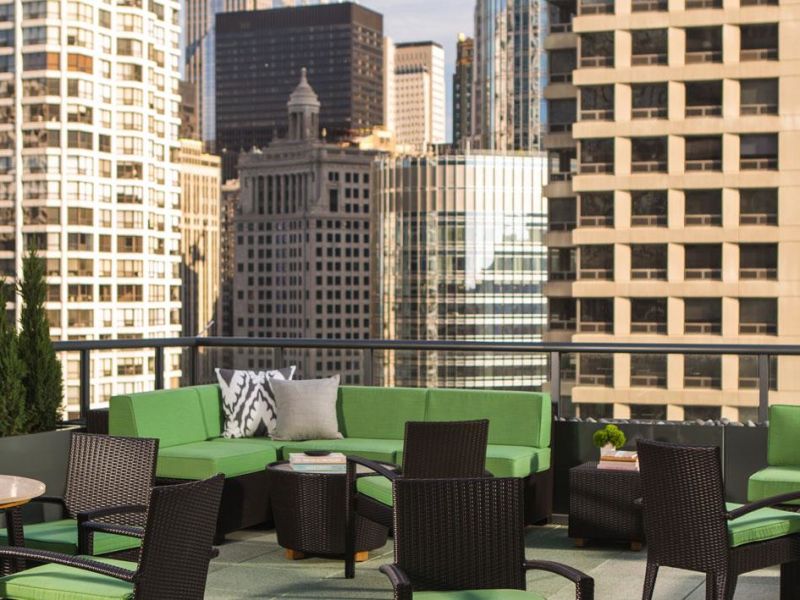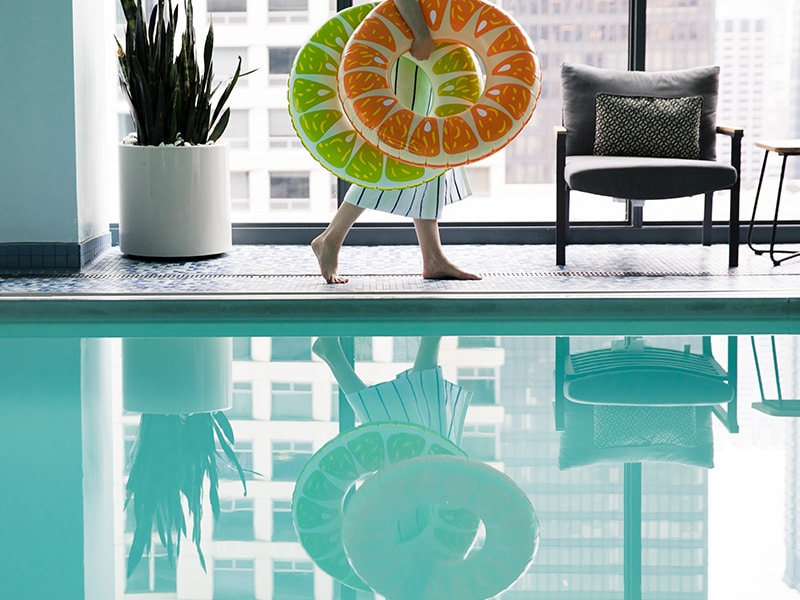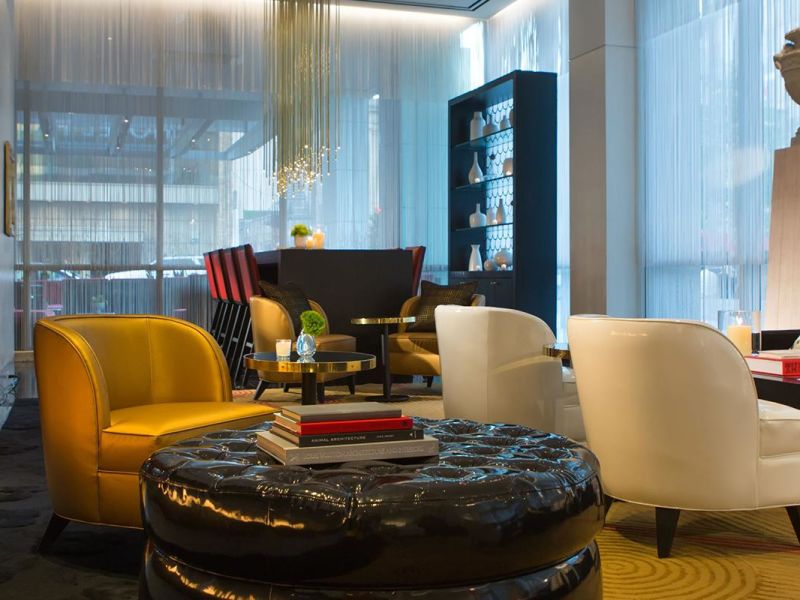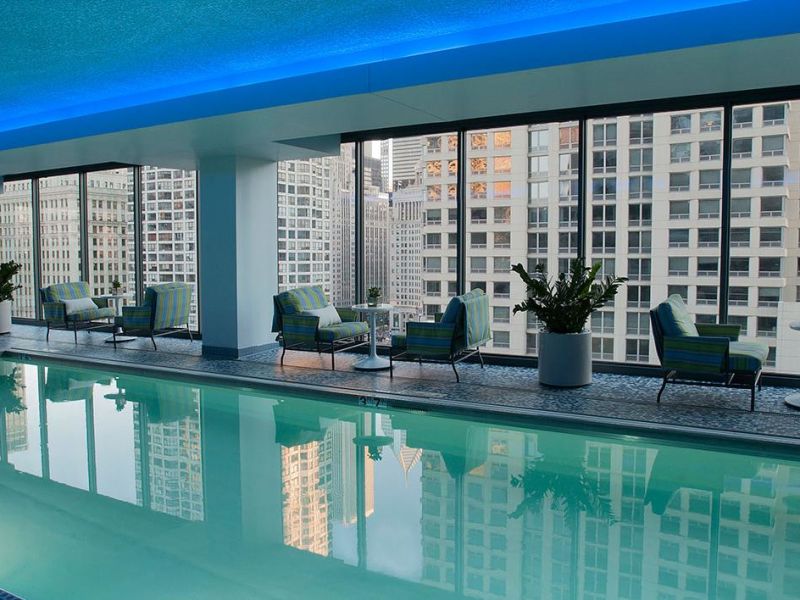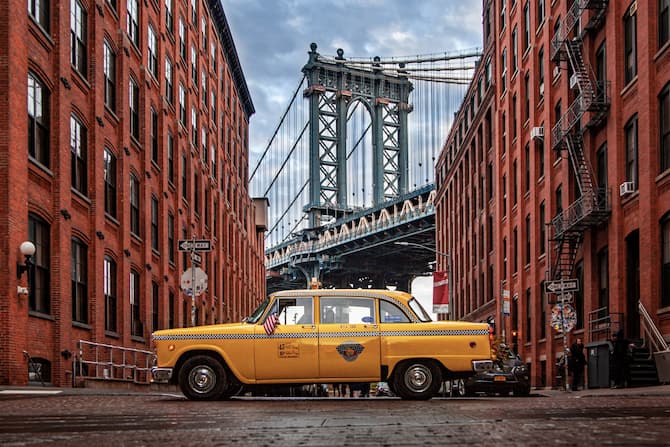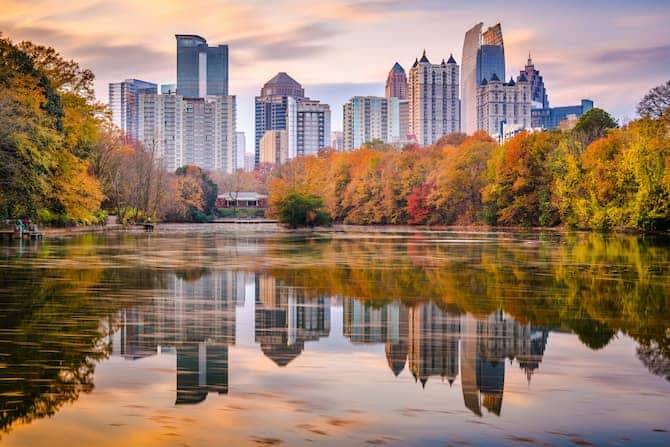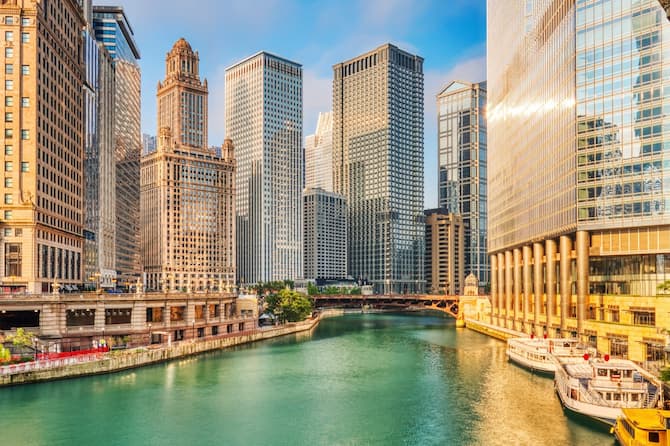
Few cities tell their story through steel and stone quite like Chicago. As the birthplace of the skyscraper, the city rose from the ashes of the Great Fire of 1871 to become a global icon of architectural innovation. From the pioneering vision of Louis Sullivan to bold modernist statements, Chicago’s skyline is a living museum of design and ambition.
What makes it even better?
You don’t need a car to explore it. Downtown Chicago is refreshingly walkable, an open-air gallery where every turn reveals another masterpiece.
Whether you’re drawn to historic gems or sleek towers of glass and steel, the city invites you to discover it on foot. Starting from the heart of it all at a Royal Sonesta hotel, this walking tour guides you through some of Chicago’s most iconic architectural landmarks, one step, one story, one stunning structure at a time.
Start Your Tour from a Royal Sonesta
Before we step into Chicago’s skyline story, let’s get oriented. With three hotels in the city’s most walkable and architecturally rich neighborhoods, The Royal Sonesta puts you in just the right spot to start exploring.
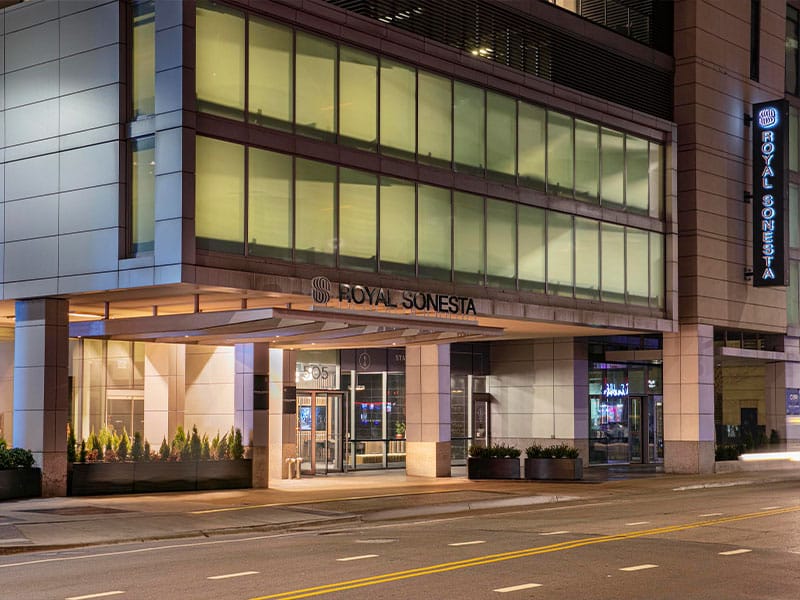
The Royal Sonesta Chicago River North
505 N State Street, Chicago, IL 60654
Nestled in a vibrant neighborhood just across the river from the Wrigley Building and Tribune Tower, this sophisticated stay places you at the heart of the city’s modern energy.

The Allegro Royal Sonesta Hotel Chicago Loop
171 W Randolph Street, Chicago, IL 60601
A historic hotel in the heart of the theater district, just minutes from the Rookery Building, Willis Tower, and Chicago Board of Trade—perfect for travelers who want character and convenience.

The Royal Sonesta Chicago Downtown
71 E Wacker Drive, Chicago, IL 60601
Set right on the riverfront, this sleek high-rise offers sweeping views and instant access to the Chicago Riverwalk, Millennium Park, and Loop landmarks.
To keep things clear and easy to follow, this route begins at The Royal Sonesta Chicago River North, but you’ll find yourself well-positioned no matter where you check in.
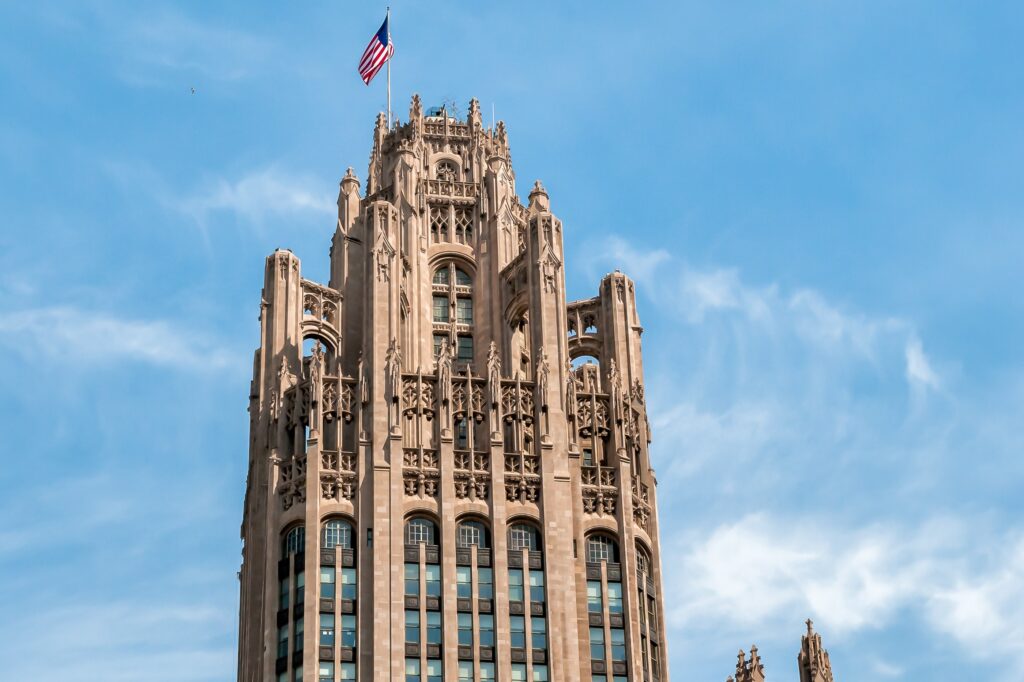
Tribune Tower, the first stop from The Royal Sonesta Chicago River North, stands in full Gothic Revival grandeur just steps away.
Stop 1: Tribune Tower
- Address: 435 Michigan Ave, Chicago, IL 60611
- Map It: Get Directions
Just steps from The Royal Sonesta Chicago River North, heading east on Illinois Street brings you face-to-face with one of Chicago’s most iconic buildings: the Tribune Tower. It’s a striking introduction to the city’s architectural legacy—and the perfect place to begin your tour.
Completed in 1925 as the result of an international design competition held by the Chicago Tribune, the building is a masterwork of Gothic Revival architecture. Designed by New York firm Howells & Hood, the tower’s vertical lines, flying buttresses, and intricate stonework evoke the grandeur of European cathedrals while anchoring it firmly in the modern skyline.
But what makes the Tribune Tower truly unique is what’s embedded into its very walls: more than 150 stones and fragments from world landmarks, including the Great Wall of China, the Parthenon, and even the Moon. These pieces were gathered by Tribune correspondents over decades and set into the base of the building—a kind of global time capsule hidden in plain sight.
While the building once housed the headquarters of the Chicago Tribune, it was recently converted into luxury residences and retail space, with its historic exterior beautifully preserved. The Tribune Tower still holds a quiet authority on Michigan Avenue—more time capsule than relic, with stories quite literally written into its walls.
Reaching the Tribune Tower from Other Hotels
Guests staying at The Royal Sonesta Chicago Downtown can reach the Tribune Tower in about 7-10 minutes, just a scenic stroll across the Michigan Avenue Bridge.
Guests at The Allegro Royal Sonesta Hotel Chicago Loop can take a relaxing 20-minute walk or reach the Tower via public transport in 15 minutes.
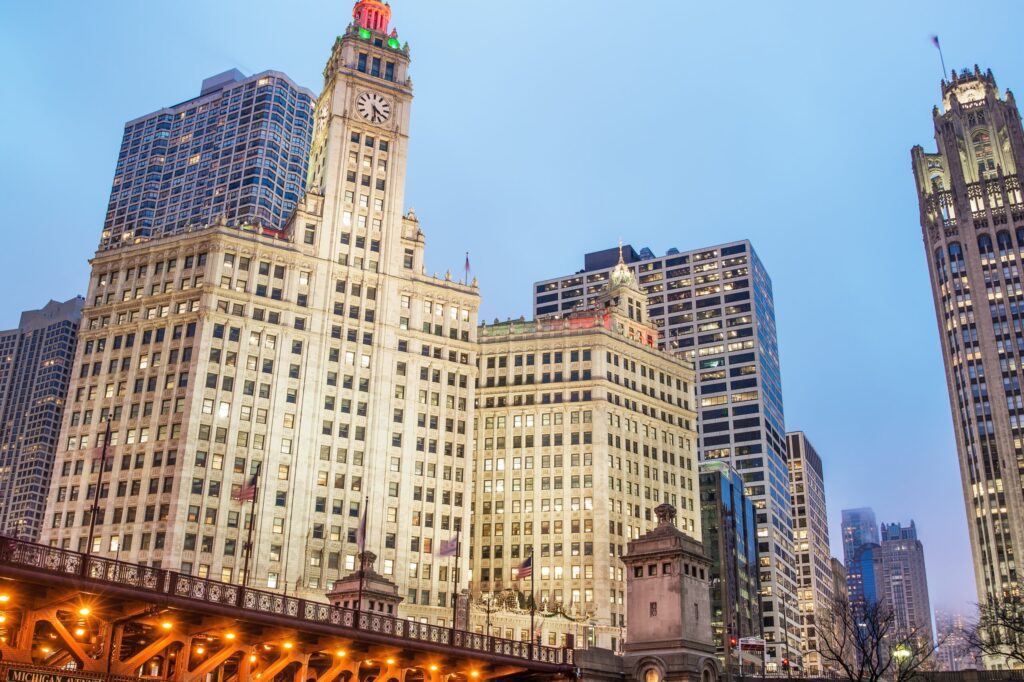
The Wrigley Building’s glowing white terra-cotta and signature clock tower make it one of Chicago’s most iconic sights.
Stop 2: Wrigley Building
- Address: 400-410 Michigan Ave, Chicago, IL 60611
- Map It: Get Directions
Cross Michigan Avenue from Tribune Tower and you’ll find yourself in front of its bright, elegant counterpart: the Wrigley Building. The contrast is immediate and intentional, and it’s one of Chicago’s most memorable skyline moments.
Completed in the 1920s as the headquarters for the Wrigley chewing gum company, this two-tower landmark blends Beaux-Arts elegance with a touch of Spanish Revival flair, inspired in part by the La Giralda tower in Seville, Spain.
Its most defining feature?
The building’s striking white terra-cotta facade, which gleams in the sunlight and lights up beautifully at night. Every inch is detailed with intricate ornamentation, from its clock tower to the arched bridge that connects its two wings.
Today, the Wrigley Building also serves as a symbolic gateway to the Magnificent Mile, marking the start of one of the most famous shopping streets in the country.
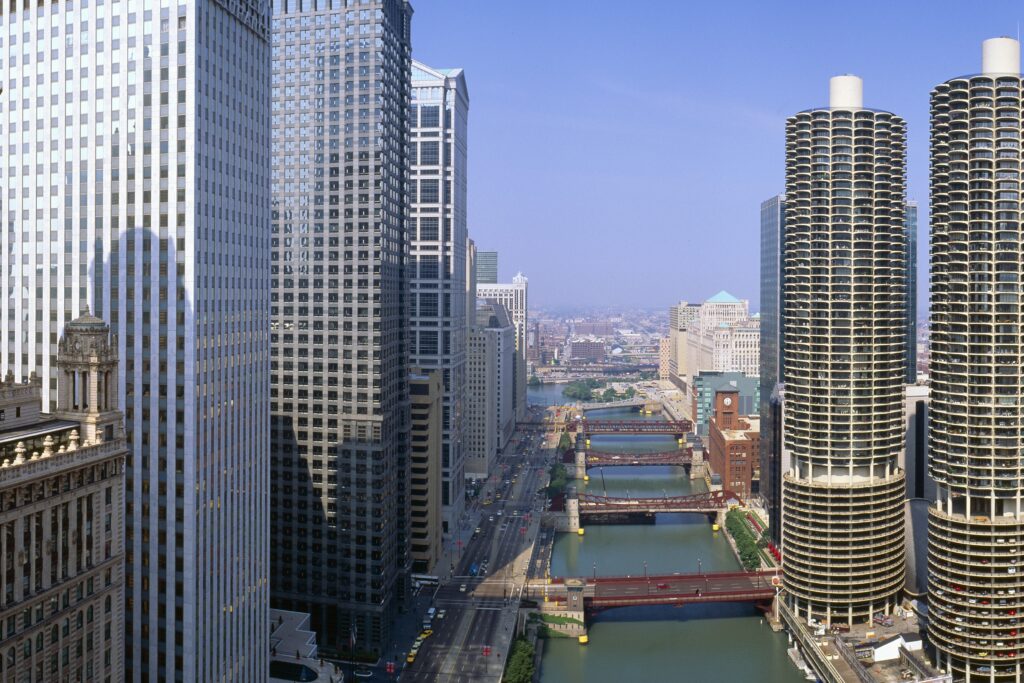
Marina City’s iconic twin towers, often nicknamed the “corncob buildings,” rise along the riverfront, a standout of Chicago’s mid-century modern skyline.
Stop 3: Marina City
- Address: Chicago, IL 60654
- Map It: Get Directions
Leaving the Wrigley Building behind, your route takes a more modern turn. As you cross the Chicago River via Wabash Avenue, a pair of curving towers rise into view—unmistakably Marina City, a bold experiment in urban living that still feels ahead of its time.
Designed by architect Bertrand Goldberg and completed in the 1960s, Marina City was envisioned as a “city within a city,” a self-contained vertical community for downtown dwellers.
The twin towers, often called “corncob towers” for their scalloped shape, were radical at the time. They offered a complete lifestyle: apartments, a theater, offices, restaurants, and even a marina at the base.
Architecturally, Marina City is a defining example of mid-century modernism, but its influence runs deeper. Goldberg’s goal was to counteract the exodus to the suburbs by making city life desirable again, something that feels especially relevant today.
With its mixed-use vision and bold sculptural form, Marina City helped shift how architects and planners thought about density, design, and livability in American cities.
Today, the towers remain residential, and their silhouette is among the most recognizable in Chicago. Whether you’re admiring their curves from the bridge or spotting them in films like The Hunter or Transformers, Marina City stands as a symbol of Chicago’s architectural daring.
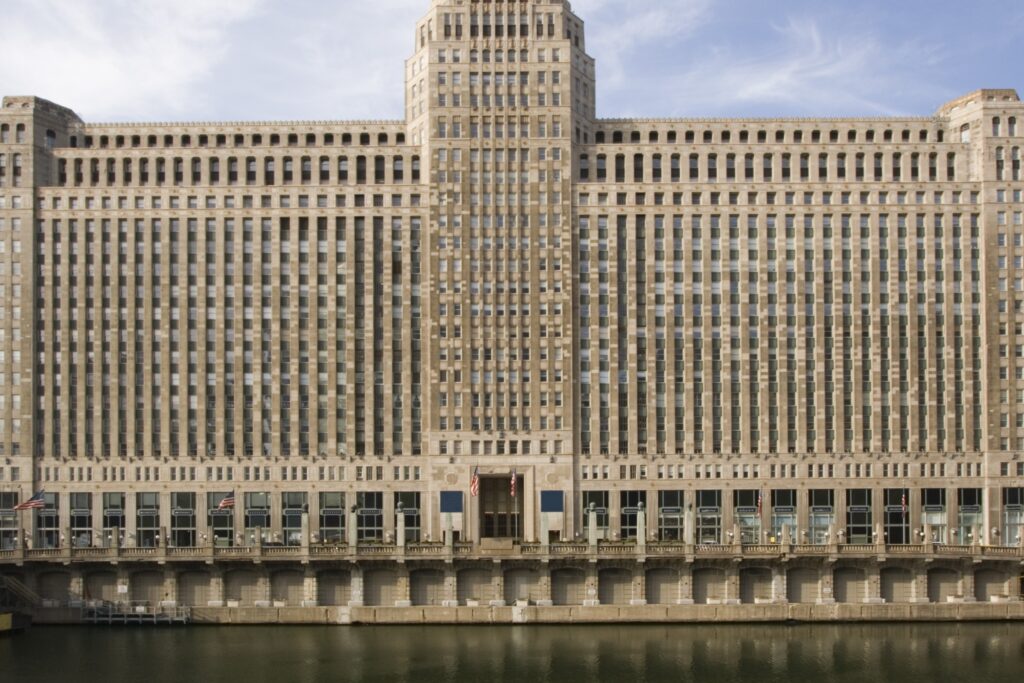
The Merchandise Mart’s Art Deco façade once fronted the largest building in the world, now a hub for design and innovation.
Stop 4: The Merchandise Mart
- Address: 222 W Merchandise Mart Plaza, Chicago, IL 60654
- Map It: Get Directions
Your next stop is the Merchandise Mart, just a 10-minute walk from Marina City. Whether you follow the Riverwalk or take Kinzie Street west, you’ll spot it easily—an enormous Art Deco structure stretching across two full city blocks along the Chicago River.
Guests coming from The Allegro Royal Sonesta Hotel Chicago Loop can also reach it on foot in just over 10 minutes, cutting straight up Wells Street.
Completed in 1930, the Merchandise Mart was the largest building in the world at the time, spanning over four million square feet and occupying two full city blocks.
Developed by Marshall Field & Co. and later owned by the Kennedy family, it was built as a central marketplace to house Chicago’s wholesale goods under one roof, a vision of vertical commerce during the Great Depression.
Architecturally, the building is a monumental example of Art Deco design, with strong lines, geometric detailing, and bronze-framed windows that nod to the era’s industrial optimism. Its limestone façade and sheer scale give it a presence that’s both elegant and imposing.
Today, the Mart has evolved into a hub for design, technology, and innovation. It’s home to showrooms, creative workspaces, and tech startups, including Chicago’s tech incubator, 1871. While its purpose has shifted, the building’s role as a center of commerce and creativity remains firmly intact.
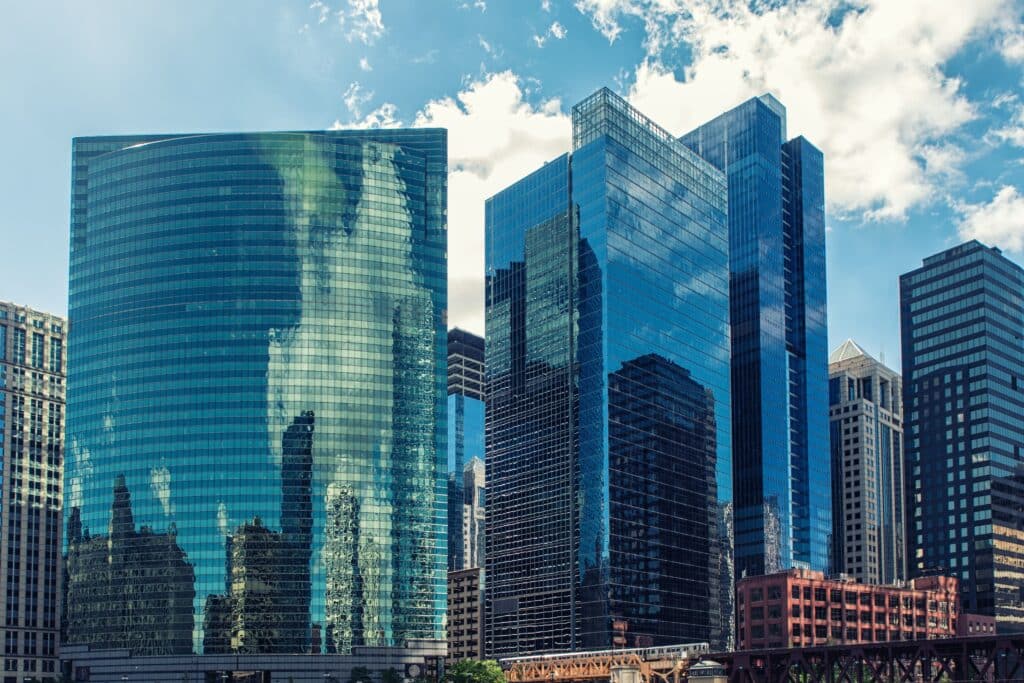
333 West Wacker’s curved glass facade mirrors the bend of the river, an icon of postmodern design along the waterfront.
Stop 5: 333 West Wacker Drive
- Address: 333 W Wacker Dr, Chicago, IL 60606
- Map It: Get Directions
From the Merchandise Mart, the walk to 333 West Wacker Drive takes just five to seven minutes. Head southwest across the Franklin Street bridge and follow the curve of the river—you’ll notice the building long before you reach it.
With its shimmering, green-tinted glass and sweeping crescent shape, 333 West Wacker Drive is a standout of postmodern architecture. Completed in 1983 and designed by Kohn Pedersen Fox, the building was one of the first in the U.S. to fully embrace the curvature of its site, using the bend in the river to shape its dramatic, reflective facade.
The building’s river-facing side mirrors the Chicago River’s arc, creating a near-continuous wave of glass that catches light, sky, and cityscape alike. It was a striking departure from the rectilinear boxes of mid-century modernism and helped reintroduce form and context into corporate architecture.
At the time of its construction, 333 West Wacker received widespread praise and even made a cameo in Ferris Bueller’s Day Off. Today, it continues to be admired not only for its design but for how it engages with its surroundings—an elegant reminder that great architecture responds to place, not just purpose.

With its French Baroque details and iconic marquee, the Chicago Theatre remains a showpiece of elegance and performance in the Loop.
Stop 6: The Chicago Theatre
- Address: 175 N State St, Chicago, IL 60601
- Map It: Get Directions
From 333 West Wacker Drive, continue east along Lake Street for about 10 minutes. As the sleek glass towers give way to the energy of the Loop, you’ll soon spot a glowing vertical sign that needs no introduction: CHICAGO.
For guests staying at The Allegro Royal Sonesta Hotel Chicago Loop or The Royal Sonesta Chicago Downtown, the Chicago Theatre is just a quick walk, less than half a mile from either hotel.
The Chicago Theatre, built in 1921, is one of the city’s most beloved landmarks and a centerpiece of its vibrant theater district.
Designed by the architectural firm Rapp and Rapp, the building is a grand example of French Baroque style, with an arched stained-glass window, ornate columns, and a lavish, seven-story lobby modeled after the Palace of Versailles.
Its most iconic feature is the marquee—that red-and-gold sign with bold white lettering, framed in lights, which has become a symbol of the city itself.
While the theatre originally opened as a movie palace, it has since hosted a wide range of performances, from vaudeville acts to comedy, concerts, and Broadway shows.
Step inside and you’ll find crystal chandeliers, sweeping staircases, and murals that feel more like a royal opera house than a Midwestern playhouse.
The Chicago Theatre offers a dramatic pause in the city’s rhythm and a reminder of the era when entertainment was as much about elegance as it was about the show.
Stop 7: The Rookery Building
- Address: 209 S LaSalle St, Chicago, IL 60604
- Map It: Get Directions
From the bright lights of the Chicago Theatre, it’s a short walk south, deeper into the Loop, where steel-and-stone history reveals itself in quieter, more deliberate ways. Tucked at the corner of LaSalle and Adams Streets is the Rookery Building, a true landmark in the evolution of the American skyscraper.
Completed in 1888 and designed by the architectural duo Daniel Burnham and John Root, the Rookery Building is one of the oldest standing high-rises in Chicago. It blends structural innovation with decorative beauty, its exterior combining Romanesque and Moorish influences, while its internal steel frame was a bold step toward what we now think of as modern skyscraper construction.
Inside, the building holds one of its most remarkable features: the light court redesigned by Frank Lloyd Wright in 1905.
With its white marble surfaces, winding staircase, and delicately ornamented ironwork, the space glows with natural light and architectural intention, serving as both centerpiece and sanctuary.
The Rookery Building’s significance isn’t just in its age or aesthetic; it’s in how it bridges eras. It captures a moment when Chicago was redefining what cities could look like, and continues to stand as a masterclass in adaptation, collaboration, and enduring style.
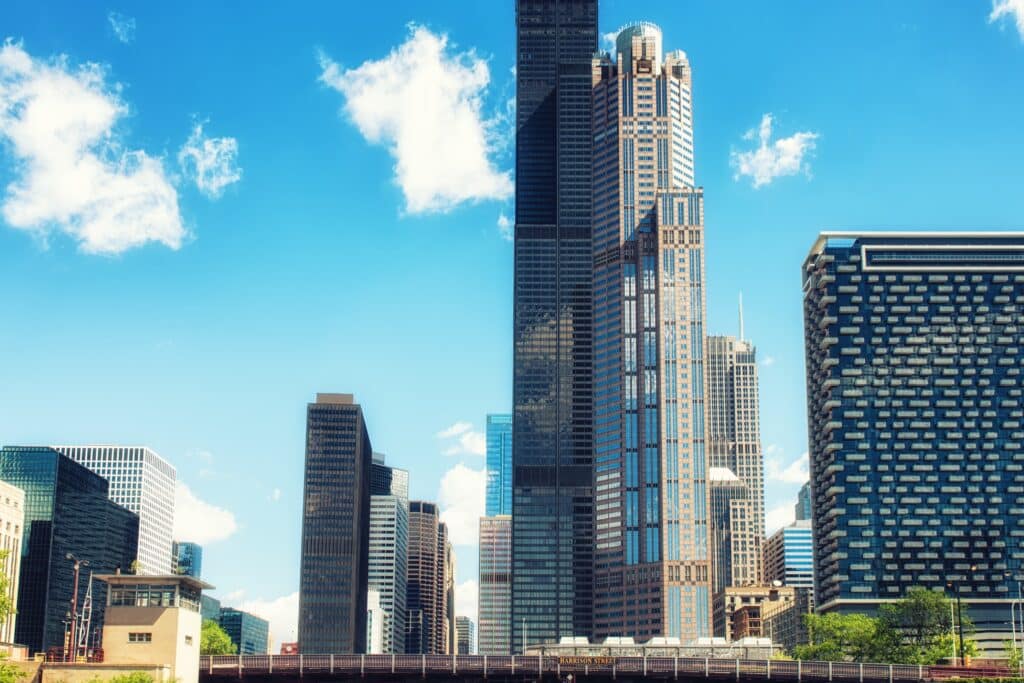
Willis Tower’s stacked-tube design redefined the skyscraper, combining bold height with structural clarity.
Stop 8: Willis Tower
- Address: 233 S Wacker Dr, Chicago, IL 60606
- Map It: Get Directions
From the quiet grandeur of the Rookery Building, continue west along Adams Street. In just under 10 minutes, the sidewalk view shifts dramatically upward, as the Willis Tower begins to rise into frame, dominating the city’s skyline even before you arrive at its base.
Formerly known as the Sears Tower, the building was completed in 1973 and held the title of world’s tallest building for nearly 25 years. Designed by Skidmore, Owings & Merrill, its minimalist modernist design is both bold and efficient.
The bundled-tube structure, a system of nine square “tubes” at staggered heights, was revolutionary for its time. It made extreme vertical growth structurally sound, anchoring the tower against Chicago’s powerful winds.
Soaring to 1,450 feet (not including its antennas), the Willis Tower is more than just a feat of engineering; it’s a vertical symbol of the city’s ambition. Clad in black aluminum and bronze-tinted glass, the tower is instantly recognizable and remains a fixture in both Chicago’s skyline and architectural legacy.
The building’s most popular draw today is the Skydeck, located on the 103rd floor. Ticketed visitors can take in panoramic views that stretch across four states, and for those who dare, step out onto The Ledge, a series of glass boxes that extend beyond the building’s edge, offering a heart-racing view straight down to the city below.
Stop 9: Chicago Board of Trade Building
- Address: 141 W Jackson Blvd, Chicago, IL 60604
- Map It: Get Directions
From the Willis Tower, walk south on Franklin Street and turn left onto Jackson Boulevard. In just under ten minutes, you’ll reach the base of LaSalle Street, where the Chicago Board of Trade Building rises with classic symmetry and carved stone elegance.
Completed in 1930 and designed by Holabird & Root, this 44-story skyscraper is a defining example of Art Deco architecture. Its limestone façade, tiered setbacks, and vertical piers create a striking silhouette, bold and refined, like the era it came from.
At the very top stands a 31-foot statue of Ceres, the Roman goddess of agriculture. She reflects the building’s origins as a center for grain and futures trading, and remains faceless, as no one in 1930 expected a rooftop view.
Inside, the three-story lobby is a showstopper, with brass accents, polished marble, and a skylight that glows above the now-quiet trading floor. When it opened, it was the tallest building in Chicago and a symbol of the city’s financial ambitions.
Today, it’s a National Historic Landmark, still commanding attention, and even screen time, with a cameo in The Dark Knight. Nearly a century later, it remains a pillar of power in the city’s architectural story.
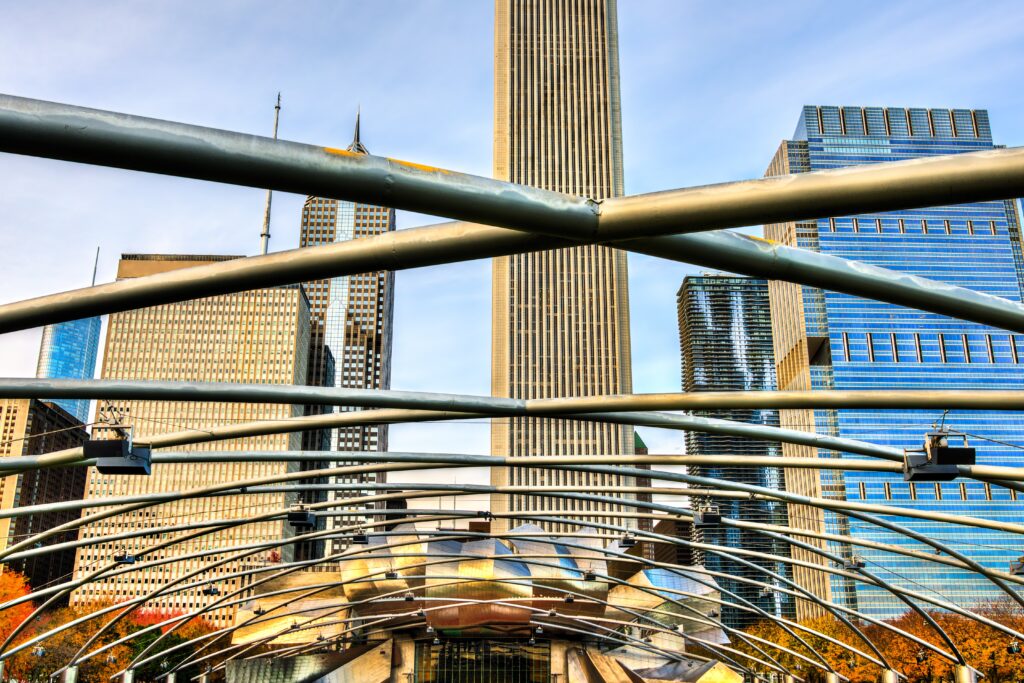
Frank Gehry’s Jay Pritzker Pavilion brings sculptural drama to Millennium Park’s open-air stage.
Stop 10: Cloud Gate & Jay Pritzker Pavilion, Millennium Park
- Address: 201 E Randolph St, Chicago, IL 60601
- Map It: Get Directions
From the base of LaSalle Street, continue north and then east along Adams Street or Jackson Boulevard. In about ten minutes, the classic contours of Chicago’s financial district give way to something more sculptural, more open. You’ve arrived at Millennium Park, the city’s contemporary front yard and the perfect finale to your walking tour.
Guests at The Royal Sonesta Chicago Downtown are just a 10-minute walk from Millennium Park and its most famous landmarks.
First, you’ll likely spot Cloud Gate, though most simply call it The Bean. Created by British artist Anish Kapoor and unveiled in 2006, the polished, stainless steel sculpture reflects the skyline and everyone who walks around (and under) it.
Inspired by liquid mercury, its curved form turns the city itself into part of the artwork. It’s one of the most photographed places in Chicago—and one of the most playful.
Just steps away, the sweeping curves of the Jay Pritzker Pavilion rise in brushed stainless steel, designed by renowned architect Frank Gehry. Its open-air stage and sculptural ribbons set the tone for year-round performances, from orchestras to film screenings, all framed by the curving trellis of speakers that extend into the Great Lawn.
Together, these two landmarks represent a different chapter in Chicago’s architectural story. Where earlier stops celebrated steel, stone, and commerce, Millennium Park is all about interaction, culture, and public space. It’s a place to pause, reflect, and look back—literally—on the skyline you’ve just explored.
Where Design Meets Your Stay: The Architecture of Royal Sonesta Hotels in Chicago
Chicago is a city that speaks through its buildings, and that includes where you check in.
Each of the three Royal Sonesta hotels in downtown Chicago reflects its neighborhood’s character, with architectural details that reflect their surroundings, whether it’s clean-lined modernism, bold historic detailing, or skyline-facing design made to connect you to the city outside.

The Royal Sonesta Chicago River North
Tucked into one of Chicago’s most energetic neighborhoods, this hotel’s contemporary exterior pairs sleek glass with bold architectural lines, matching the creative energy of River North. Its façade speaks to urban elegance, standing in step with nearby galleries, loft-style buildings, and modern towers that define this art-forward district
Inside, the design carries a residential feel with a modern edge, featuring clean materials, gallery-inspired artwork, and spa suites that mirror the district’s love of form and comfort.
With sculptural lighting, rich textures, and thoughtful furnishings, the interiors offer a calm counterpoint to the buzz of the city just outside.
Visit The Royal Sonesta Chicago River North
The Allegro Royal Sonesta Hotel Chicago Loop
A true Chicago landmark, The Allegro occupies the historic site of the original Bismarck Hotel, rebuilt in 1926 in full Art Deco flair. Designed by the firm Rapp and Rapp, the façade remains a standout in the Loop’s theater district—angular, dramatic, and unmistakably rooted in the city’s cultural legacy.
View this post on Instagram
Inside, the hotel retains the grandeur of its Prohibition-era heyday. Marble staircases, restored vintage lighting, and bold brass details reflect its glamorous past, where vaudeville stars, movie legends, and political powerhouses once passed through.
Today, the interiors honor this layered history with moody Art Deco styling, plush materials, and bold geometric accents that feel both timeless and theatrical.
Visit The Allegro Royal Sonesta Hotel Chicago Loop
The Royal Sonesta Chicago Downtown
Positioned along Wacker Drive, this tower-like property presents a modern interpretation of the city’s vertical rhythm. Its glassy exterior is designed to reflect the river it overlooks, framing Chicago’s skyline in every pane and standing as part of the architectural conversation that surrounds it.
View this post on Instagram
The interiors open up to a more transitional style, offering expansive views through floor-to-ceiling windows and clean, understated detailing. Wood, metal, and stone textures add warmth, while the neutral palette lets the urban landscape take center stage.
Throughout, the design emphasizes connectivity with the city, the river, and the comfort of contemporary hospitality.
Visit The Royal Sonesta Chicago Downtown
With thoughtfully designed accommodations near top attractions, Sonesta provides easy access to everything Chicago has to offer, plus exclusive perks through the Sonesta Travel Pass loyalty program.
Disclaimer: The suggested itinerary and points of interest are provided for informational and planning purposes only. Guests are encouraged to independently verify opening hours, availability, travel times, and any potential changes prior to visiting. The inclusion of any businesses, attractions, or destinations does not imply affiliation with or endorsement by Sonesta or its affiliates. Sonesta makes no representations or warranties regarding the accuracy or completeness of the information provided and assumes no responsibility for any inconvenience or loss arising from the use of this information.
